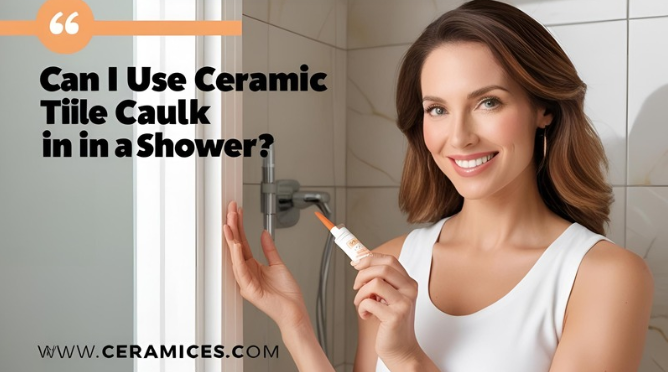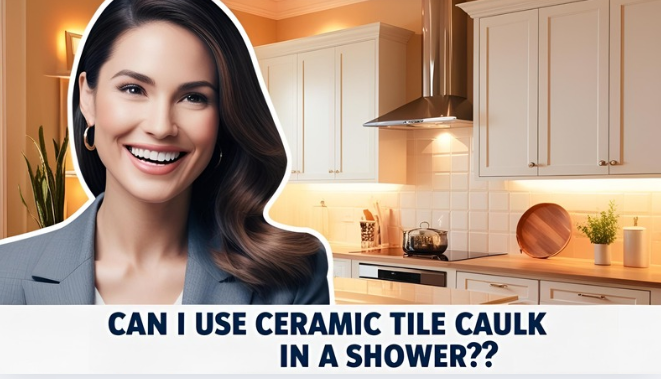When it comes to maintaining and renovating your shower, one of the most common questions is, “Can I use ceramic tile caulk in a shower?” Ceramic tile caulk is a versatile material used for sealing gaps and joints, but its suitability for shower environments depends on several factors. This article will explore the types of caulk suitable for showers, the benefits and limitations of ceramic tile caulk, and best practices for application and maintenance. Whether you’re a DIY enthusiast or a homeowner looking to refresh your bathroom, this guide will provide you with all the information you need about using ceramic tile caulk in a shower.
What is Ceramic Tile Caulk?
Ceramic tile caulk is a flexible, waterproof sealant used to fill gaps and joints between tiles, especially in areas prone to moisture. It is designed to adhere to ceramic surfaces and provide a durable, watertight seal. Caulk is commonly used in bathrooms, kitchens, and other wet areas to prevent water infiltration and mold growth.
Key Components:
- Base Material: Typically silicone, latex, or a hybrid of both.
- Additives: Include fungicides and mildewcides to prevent mold and mildew growth.
- Color Options: Available in various colors to match your tile and grout.
Can I Use Ceramic Tile Caulk in a Shower?

Yes, you can use ceramic tile caulk in a shower, but it’s essential to choose the right type of caulk for the job. Showers are high-moisture environments, so the caulk must be waterproof, mold-resistant, and durable. Here’s what to consider:
1. Type of Caulk
Not all caulks are created equal. For showers, you need a caulk specifically designed for wet environments. The most common types are:
- Silicone Caulk: Highly waterproof and flexible, ideal for showers.
- Latex Caulk: Easier to apply and clean up but less durable in wet environments.
- Hybrid Caulk: Combines the benefits of silicone and latex, offering good adhesion and flexibility.
2. Mold and Mildew Resistance
Showers are prone to mold and mildew, so choose a caulk that contains fungicides and mildewcides to prevent growth.
3. Flexibility
The caulk must remain flexible to accommodate the expansion and contraction of tiles due to temperature changes.
4. Adhesion
Ensure the caulk adheres well to both ceramic tiles and the substrate (e.g., drywall, cement board).
5. Curing Time
Different caulks have different curing times. Follow the manufacturer’s instructions for the best results.
Benefits of Using Ceramic Tile Caulk in a Shower
Using ceramic tile caulk in a shower offers several advantages:
1. Waterproof Seal
Ceramic tile caulk provides a waterproof barrier, preventing water from seeping into gaps and causing damage.
2. Mold and Mildew Resistance
Caulk with added fungicides and mildewcides helps prevent mold and mildew growth, maintaining a clean and healthy shower environment.
3. Flexibility
High-quality caulk remains flexible, accommodating the movement of tiles and preventing cracks.
4. Aesthetic Appeal
Available in various colors, ceramic tile caulk can be matched to your tile and grout, ensuring a seamless look.
5. Ease of Application
Most ceramic tile caulks are easy to apply with a caulking gun, making them suitable for DIY projects.
Limitations of Using Ceramic Tile Caulk in a Shower
While ceramic tile caulk is beneficial, there are some limitations to consider:
1. Durability
Caulk can degrade over time, especially in high-moisture environments. Regular maintenance and reapplication may be necessary.
2. Application Challenges
Achieving a smooth, even bead of caulk can be challenging for beginners. Practice and the right tools are essential.
3. Curing Time
Some caulks require extended curing times, during which the shower cannot be used.
4. Compatibility
Ensure the caulk is compatible with your specific tile and substrate materials.
Steps to Apply Ceramic Tile Caulk in a Shower

To achieve a professional-looking finish when applying ceramic tile caulk in a shower, follow these steps:
1. Gather Materials
You will need the following materials:
- Caulk: Silicone or hybrid caulk designed for showers.
- Caulking Gun: For easy application.
- Utility Knife: For cutting the caulk tube tip.
- Painter’s Tape: To protect surrounding areas.
- Damp Cloth or Sponge: For smoothing the caulk.
- Rubbing Alcohol: For cleaning the surface.
2. Prepare the Surface
Thoroughly clean the area where you will apply the caulk. Remove old caulk, dirt, and grime using a utility knife and rubbing alcohol. Ensure the surface is dry before proceeding.
3. Apply Painter’s Tape
Use painter’s tape to mask off the areas around the joint. This will help you achieve a clean, straight line.
4. Cut the Caulk Tube Tip
Cut the tip of the caulk tube at a 45-degree angle. The size of the hole should match the width of the gap you need to fill.
5. Load the Caulking Gun
Insert the caulk tube into the caulking gun and push the plunger until caulk begins to come out of the tip.
6. Apply the Caulk
Hold the caulking gun at a 45-degree angle and apply a steady bead of caulk along the joint. Move the gun smoothly and evenly to ensure consistent coverage.
7. Smooth the Caulk
Use a damp cloth or sponge to smooth the caulk bead. Wipe away any excess caulk and remove the painter’s tape while the caulk is still wet.
8. Allow to Cure
Allow the caulk to cure according to the manufacturer’s instructions. This can take anywhere from 24 hours to several days.
Tips for Applying Ceramic Tile Caulk in a Shower
To ensure a successful caulking project, follow these tips:
1. Choose the Right Caulk
Select a high-quality silicone or hybrid caulk designed for showers. Ensure it is mold and mildew resistant.
2. Proper Preparation
Thoroughly clean and dry the surface before applying caulk. Remove old caulk and debris to ensure good adhesion.
3. Use Painter’s Tape
Painter’s tape helps achieve clean, straight lines and protects surrounding areas from excess caulk.
4. Apply Evenly
Apply the caulk in a steady, even bead. Avoid stopping and starting, as this can create uneven lines.
5. Smooth Immediately
Smooth the caulk bead immediately after application using a damp cloth or sponge. This helps achieve a professional finish.
6. Allow Adequate Curing Time
Follow the manufacturer’s instructions for curing time. Avoid using the shower until the caulk is fully cured.
7. Maintain the Caulk
Regularly inspect the caulk for signs of wear or damage. Reapply as needed to maintain a watertight seal.
Common Uses for Ceramic Tile Caulk in a Shower
Ceramic tile caulk is used in various areas of a shower to prevent water infiltration and maintain a clean, finished look:
1. Tile Joints
Seal the joints between tiles to prevent water from seeping behind the tiles and causing damage.
2. Corners
Apply caulk to the corners where walls meet to create a watertight seal.
3. Edges
Seal the edges where tiles meet fixtures, such as showerheads, faucets, and drains.
4. Baseboards
Caulk the baseboards where they meet the floor to prevent water from seeping underneath.
5. Niche and Shelves
Seal the edges of shower niches and shelves to prevent water from pooling and causing damage.
FAQs: Can I Use Ceramic Tile Caulk in a Shower?
1. Can I use ceramic tile caulk in a shower?
Yes, but choose a caulk specifically designed for wet environments, such as silicone or hybrid caulk.
2. What type of caulk is best for showers?
Silicone caulk is the best choice for showers due to its waterproof and flexible properties.
3. How do I apply caulk in a shower?
Clean the surface, apply painter’s tape, cut the caulk tube tip, apply a steady bead, smooth with a damp cloth, and allow to cure.
4. How long does caulk take to cure in a shower?
Curing times vary by product but typically range from 24 hours to several days.
5. Can I use latex caulk in a shower?
Latex caulk is less durable in wet environments and is not recommended for showers. Use silicone or hybrid caulk instead.
6. How do I remove old caulk from a shower?
Use a utility knife or caulk removal tool to scrape away old caulk. Clean the area with rubbing alcohol before applying new caulk.
7. How often should I recaulk my shower?
Inspect the caulk regularly and recaulk as needed, typically every 1-2 years, depending on wear and tear.
8. Can I paint over caulk in a shower?
Some caulks are paintable, but it’s best to check the manufacturer’s guidelines. Use a high-quality bathroom paint if painting over caulk.
9. What should I do if caulk starts to peel in my shower?
Remove the peeling caulk, clean the area, and reapply new caulk to maintain a watertight seal.
10. Can I use ceramic tile caulk on other surfaces?
Yes, ceramic tile caulk can be used on various surfaces, including glass, metal, and plastic, provided it is compatible.
Conclusion: Can I Use Ceramic Tile Caulk in a Shower?
Yes, you can use ceramic tile caulk in a shower, provided you choose the right type of caulk and follow proper application techniques. Silicone and hybrid caulks are ideal for showers due to their waterproof, flexible, and mold-resistant properties. By following best practices such as thorough surface preparation, even application, and adequate curing time, you can achieve a durable and professional-looking seal.
So, the next time you ask, “Can I use ceramic tile caulk in a shower?” remember that with the right materials and techniques, you can maintain a watertight and aesthetically pleasing shower environment. Whether you’re sealing tile joints, corners, or edges, ceramic tile caulk offers a practical and effective solution for keeping your shower in top condition. By making informed decisions and following proper care guidelines, you can extend the lifespan of your caulk and enjoy a clean, functional shower for years to come.
Read more
1 How to Install a Grab Bar in a Ceramic Tile Shower: Step-by-Step